DRONES provide a cutting-edge fishing technique that opens the door to a whole new world of opportunity.
And this next-generation technology is now available at an affordable price point. The advantages drones provide are incredible. Anglers can now readily access gamefish from the beach, fish previously unfishable spots and stay safe when fishing from the rocks. Drone fishing is an amazing innovation for both land and boat-based anglers who are keen to extract the most fun from the ancient but ever-changing sport of fishing.
We continue to discover and explore opportunities that were never thought possible until high-quality waterproof drones became affordable. At Drone Fishing, we research and test drone fishing equipment and technology, so we can provide the best and latest products suited specifically to this sport.
Drone Fishing – a history
It all started when I bought a basic drone and investigated the laws regarding where I could fly it. As an unlicensed recreational drone user living in suburbia, I couldn’t find many places to fly my drone. I grew up on the Sunshine Coast and spent all my life fishing the surf and large river systems.
As a keen diver, I dived in many places just offshore that were often full of large fish but were out of casting distance. I regularly dreamt of being able to cast just that little bit further to reach the deeper gutters. Thinking about my drone, I figured all I needed was a release mechanism to drop the bait and tackle into the water once I’d flown it out.
I went to my local hobby shops to buy the mechanism and was unable to find anything suitable. As a trip to Fraser Island was coming up soon, I managed to bend some fish hooks, rig up a servo on a separate radio inside a small box and attach it to my drone. We tried it out and it worked brilliantly.
The only problem with our first trip was we kept getting snapped off by big fish, even when using 100lb mono.
My second trial was on a day trip to the Noosa North Shore on the Cooloola Coast. We drove about 20 minutes up the beach and pulled up. The weather was a bit rough and it was raining. I changed my leader to a new product I had found at the Coolum tackle shop called TUF-Leader, which is a stainless steel braid that can be tied like mono.
Using the drone to fly my baits out, I pulled in a solid jewfish and two tailor. I have used TUF-Leader a few times since and discovered it is great for sharp teeth. Since I started Drone Fishing, I have found that even people who are not interested in fishing have taken notice. I have received many positive comments and a few negative.
Once we arrive at a location we have to calibrate the drone’s compass and altitude sensors. When you know what you’re doing, this becomes a simple three-minute operation. Then once you have your rod and tackle set up you are ready to go. I find drone fishing a lot easier with an extra pair of hands to help.
When finding a spot to take off from, you must remember that the ‘Return to Home’ function will always land the drone within 2m of its take-off location. I regularly fish on beaches with four-wheel-drive access and find the best place for launching is next to your car. Prior to launch, we usually put some small traffic cones around the drone in a 3m-diameter circle.
Having two people is beneficial because one of us can walk the rod down to the water’s edge, which means when a 4X4 comes past it doesn’t drive through your line. Once you have found a good place from which to take off and land, it’s launch time. With the bait and tackle attached, I slowly fly the drone up to about 10m, being careful to keep the line and tip of the rod below the drone as it rises.
I have had new people help me occasionally and if they raise the rod too early they will snap the line. I run a Shimano Tekota overhead reel because after a lot of research I found this to be the largest, decent overhead that would carry the 600m of line I feel I need. I have tried a few different reels with the drones and have not had much luck with eggbeaters (even though they are my preferred style of reel).
People have said many things including: “That’s cheating”; “That seems too easy”; “Is that legal?”; “What happens if you crash in the ocean?”; and “Is it waterproof?”.
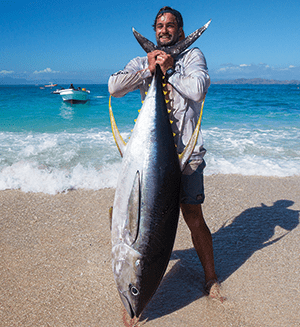
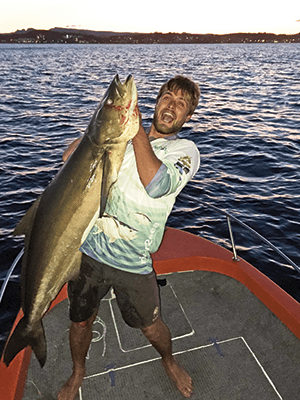
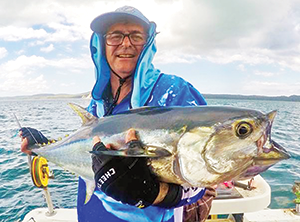
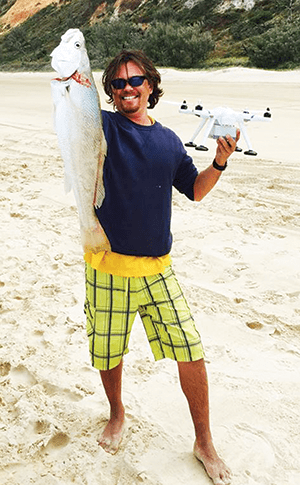
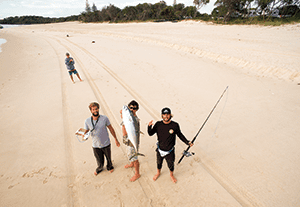
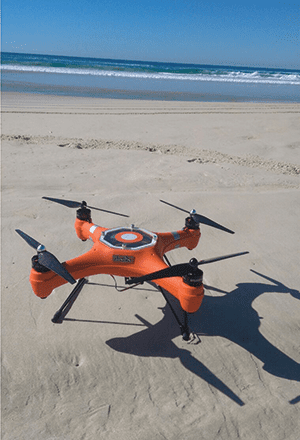
Once the drone is up, I free spool the reel with the clicker on so I have an audio link with the drone as it flies out. The clicker ensures I can hear how fast the drone is flying and feel a clear connection with it through the line. You want a little drag as the drone flies out but not too much.
I found the spring on my clicker was a bit too strong, so I replaced it with a weaker one.
Now I get my clear noise connection without extra drag. So once you are in the air with your bait and sinker hanging below the drone, slowly move the drone forwards (right control on the remote) and off she goes. Our drone is equipped with a full GPS flight controller, which will keep its position and altitude stable once you release the controls, regardless of the wind.
So if you release the controls, the drone will remain in the same place, which is unlike any RC aircraft I have flown before. I run a waterproof SwellPro Splash Drone with a fixed camera that gives me a live video feed of what is below the drone on a small screen. This is an advantage when you are flying out a long way past the breakers because the distance can be a little deceiving.
From the shore it will look like you are past the breakers but you will actually be right above them. Watching the live stream, I have also seen some big shadows of fish under the water to drop straight onto. You want to stop flying forwards once you are above the deepest back gutter or about to run out of line.
I recommend keeping an eye on your line as you fly out because you will see line on your reel you have never seen before. And when flying at over 20km/h you will be surprised how quickly your line will run out. I have set my reel up with 100m of 40lb braid under 500m of yellow line. This way I have a 100m visual alarm that my line is going to run out.
However, I’ve found I usually only need to fly 200-300m offshore. Finally, with the flick of a switch your line and bait is released into the sea. Once you have dropped the bait, flick another switch and the drone will fly back to its landing pad. You can put the remote down and watch your drone flying home while waiting for that big bite.
We have also been doing a lot of testing with flying the SwellPro Splash Drone from a boat. We have noticed that tuna never come close to the boat, and whenever you try to get close to them they will disappear. They are quite smart and elusive fish. So we decided to try drone fishing and fly our live baits 100-200m from the boat to get amongst the tuna.
My mate Wayne has caught them before using a balloon technique and floating his live bait a long way from the boat with the wind. He has chatted to me in depth about the many ways he has tried to get baits away from the boat using balloons and kites and he said it was very hard to have more than one bait in the water without getting tangled.
With the drone we were able to fly out three lines – one to the left, one to the right and one straight out the back. This way we could set our baits up to 300m apart, eliminating the risk of a tangle. After a little wait, a school of longtail tuna came through and we were on. The longtail I hooked was the most powerful fish I had ever fought.
It was so awesome that the next week I had to go out and catch another. At this stage we are looking forward to testing the latest products from around the world. The AguaDrone is ready for pre-orders in the new year and we are very excited to start testing this product in Australia because it was heavily researched and developed specifically for fishing.
It is a waterproof craft that includes a pressure-release mechanism, a fishfinder pod to send live images to your smartphone and a camera that is capable of filming 360-degree panoramic footage. We are especially looking forward to the new release Jaiden Maclean has been working on. Jaiden and his brother Brody have tried fishing styles I have not yet risked without the pressure-release mechanism.
But the Macleans started out with rubber bands and they’ve had great success catching longtail tuna by drone fishing off the beach. I am very much looking forward to doing this too. Their technique is to fly a squid out, search for the tuna using the drone’s camera and then lower the squid into them. This is not an easy feat and you need to carry a fair bit of gear to the beach when you don’t have 4WD beach access.
Drone Fishing and PicoKit have teamed up to create an internal control board that we use to modify the Xiro Xplorer drone. This board will be available for people who want to control any servo and set open/close positions off any signal, such as dimming lights or camera outputs. This product will be available on our website just before Christmas and it is designed for people with a budget of less than $1000 who want to begin drone fishing.
I started with non-waterproof drones and can honestly say I have never crashed one in the ocean. I have crashed on landing back on the beach, but if you are careful and practice flying a bit first, you will find it quite simple. The GoFish Cam is another exciting product to be released in February next year.
It is an underwater camera that can go 150m under water. It attaches to your line and will film all the action around your bait and your fish once hooked. The GoFish Cam will also have night vision capabilities. This device will be a great tool for analysing what fish are doing around your bait and seeing how they strike.
I prefer to fish on beaches with 4WD access. In southeast Queensland we are very lucky to be able to enjoy many beach driving opportunities. Moreton and Stradbroke islands are right on our doorstep, not to mention the Noosa North Shore to Rainbow Beach stretch and magnificent Fraser Island with its 100km-plus of beach.
All these areas are full of fish. I have spoken to Fisheries Queensland staff members and they have told me they have no problem with drone fishing so long as you obey regular line fishing laws and the line is connected to a rod. As a drone user, you have to be very responsible in abiding by the CASA drone flying laws (casa.gov.au/aircraft/landing-page/flying-drones-australia).
These rules are pretty basic and easy to follow. I don’t think it will be long before you see a lot of fishers using drones to great effect.
For more information, visit dronefishing.com.au
 Bush ‘n Beach Fishing Magazine Location reports & tips for fishing, boating, camping, kayaking, 4WDing in Queensland and Northern NSW
Bush ‘n Beach Fishing Magazine Location reports & tips for fishing, boating, camping, kayaking, 4WDing in Queensland and Northern NSW










Great feedback Brendan
I just started out with the drone fishing at Skeleton Coast ,Namibia
I have been trying different reels and working a drop loop which seems fine,but now i am waiting for a bigger multiplier which i had no time for when in normal beach fishing mode,as my brother in law was always busy with crows nests as i was hauling jn the fish with a coffee grinder..
After reading your blog,i can see the multiplier being my 1st choice reel.
Had a few tangle ups due to fishing in high winds in the surf,,but all fine so far,seems there are lots of advice from drone fishermen if you look through the write ups.
Great stuff,,thanks for the info,,,tight lines
Rgds
Steven
Hi Brendan,
Thank you for an excellent article on Drone fishing. I have done extensive research into drone fishing and feel you article sums up all that into one comprehensive read. I am looking forward to getting a Phantom 3 and testing it out on the beach once I become familiar with the flight , etc. Many thanks for your extensive share. Tight Lines.
Timothy Rughbeer
Durban , South Africa
Hi Brendan,
Terrific article and thank you. I have been seriously thinking about this lately. I live at Woorim, Bribie Island. I would really appreciate some further advice before I spend up on a Splash Drone 3+ rod, line, tracer etc. Would really appreciate talking to you if you can send me your contact details to my email.
Cheers …… John.
Great share found similar great content.